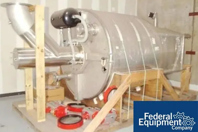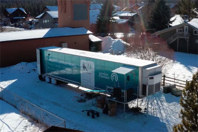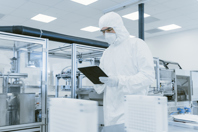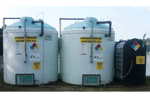Spray Nozzles
PRODUCTS
-
Qosina offers the largest stock inventory of medical valves including check valves, relief valves, hemostasis valves, luer-activated valves, tuohy borst adapters and drain valves.
-
Unused Fluid Air 300 liter fluid bed dryer, model 300, 316 stainless steel contact parts, 304 non product contact, includes tower, filter system, explosion suppression system, product bowl with automatic side discharge, hydraulic bowl lifting system, spray nozzles (for possible conversion to top spray granulation), HMI and machine controls, valves, and other associated parts, serial# 10440, built 2014.
-
In the aftermath of the COVID-19 pandemic, clinical laboratories were faced with an urgent need to rapidly expand their testing capacity. Given the importance of disease surveillance in a public health crisis, Germfree's priority was to quickly create a series of rapidly deployable laboratory spaces that could be used for disease surveillance in emergencies, as temporary laboratory spaces, and as swing spaces.
-
In pharmaceutical testing, the development and validation of analytical methods are absolute musts when it comes to reliable quality control. Natoli Scientific is at the forefront of offering comprehensive analytical method development and validation services designed to ensure the integrity of your company’s drug formulations. Our expert team develops robust methods tailored for each unique compound, with an approach that emphasizes precision, accuracy, sustainability, and compliance with regulatory standards such as the FDA and ICH guidelines. These methods are meticulously validated to confirm their reliability across a range of analytical parameters including specificity, sensitivity, linearity, and reproducibility.
This validation process is critical for verifying that our methods produce consistent, trustworthy results throughout the product’s lifecycle, thus fostering confidence in the safety and efficacy of pharmaceutical products.
-
Visualize Batch Production Like Never Before
TrackWise Experion® Batch combines compact Experion distributed control, batch automation, and advanced visualization technology to provide a solution optimized for pharmaceutical, specialty chemical, food and beverage, and similar applications.
WHITE PAPERS AND CASE STUDIES
-
Accelerate Your Oncology Breakthroughs
Finding the right partnership can help your oncology clinical trials overcome trial complexities through strategic planning, a deep scientific understanding, and operational excellence.
-
Addressing Site Selection Challenges In DMD Gene Therapy Studies
Effective site selection is critical for the success of DMD gene therapy trials. This study details innovative methodologies employed to streamline and improve site identification.
-
ArborWorks Success Story
ArborWorks, a vegetation management firm, faced a core challenge in identifying a software partner that would bring their company into a fully digital environment, using field crews on mobile devices versus paper.
-
Efficient Data Aggregation And Oversight: A CRO Success Story
Explore how a full-service CRO and tech-driven life sciences provider streamlined data aggregation and clinical trial oversight, yielding significant time and cost savings.
-
Specifying Performance Over Equipment Quickly Reduces THMs In The Colorado Springs' Distribution System
Colorado Springs, Colorado, enjoys some of the highest quality drinking water in the country, with most of its water coming from high country snowmelt. Despite its pristine origin in the mountains, the water at the far end of the distribution system is prone to developing trihalomethanes (THMs) due to low turnover and high water age.
-
The Savings Are Blowin' In At Port Washington Wastewater Treatment Plant
The municipal wastewater treatment plant in Port Washington, Wisconsin, is located on the picturesque shore of Lake Michigan, so it’s essential that their plant performs as designed.
-
Rapid And Robust Preclinical And Clinical Development Of CAR T-Cell Therapies
Streamline CAR T-cell therapy development with integrated support for asset identification, IND submission, early-phase studies, and advanced real-time tracking solutions.
-
Authentic Engagement: Reaching Underserved Lupus Patients
By partnering with the ICLF, see how we were able to gain access to and build trust with influential community leaders and advocates within the African American communities located near study sites.
-
Poultry Panic: Urgent Wastewater Fix Saves Poultry Plant From Fines
On a late Friday afternoon in June, a call came in to USP Technologies (USP): a major poultry processing plant in the southeast was in danger of violating their wastewater discharge permit.
-
Manufacturing With Specialized Material
Examine how MedBio and Natus Medical overcame the challenge of transitioning to BPA-free materials by leveraging innovative resins and rapid tooling solutions to meet production deadlines.
-
Comparative Analysis Of Batch And Continuous Processes
Explore a comparative analysis that showcases the superior performance of continuous processing over traditional batch methods, highlighting key improvements in efficiency and environmental impact.
-
Improving Patient Health And Safety: Medical Affairs
A medical affairs department needed leaders with scientific and project management expertise. With no time for training or risk tolerance, a consultant was hired to align activities with development and launch plans.
NEWS
-
Naia Prepares First Production Of GRS-Certified Yarn2/20/2024
In a significant achievement for Eastman, Naia Renew cellulosic fiber has received the Global Recycled Standard (GRS) certification. This certification validates Naia Renew’s certified recycled content, chain of custody, social and environmental practices, and chemical restrictions.
-
Topsoe Announces Plans For New State-Of-The-Art Us Electrolyzer Factory For Clean Hydrogen4/19/2024
Topsoe, a global leader in carbon emission reduction technologies, announced plans to build a cutting-edge factory in Chesterfield, Virginia. The factory will manufacture advanced, energy efficient Solid Oxide Electrolyzer Cells (SOEC) that are essential to the efficient production of clean hydrogen and derivatives like eAmmonia and eMethanol.
-
Infrafon SmartBadge, A New Disruptive Device Between Smartphone And SmartCard4/2/2024
After 3 years of ambitious development, Infrafon team is proud to present world´s first interactive security SmartBadge featuring high resolution touch enabled epaper and unparalleled radio communication features.
-
Tuesday: EPA Leaders And Congressman Soto To Announce $188M Loan To Upgrade And Expand Water Services In Central Florida8/9/2024
On Tuesday, August 13, 2024, the U.S. Environmental Protection Agency (EPA) will announce a $188.3M Water Infrastructure Finance and Innovation Act (WIFIA) loan to Toho Water Authority in central Florida.
-
Bühler Opens Application Center For Local Grains In Nigeria Together With Flour Mills Of Nigeria7/11/2024
Bühler, in collaboration with Flour Mills of Nigeria Plc, has opened a grains application center in Nigeria dedicated to processing local and ancient grains.
ABOUT
Spray Nozzles
Spray nozzles are a conceptually simple device with a very important purpose in the petrochemical industry. While designs are rarely the same, they operate under the same concepts. A spray nozzle disperses contents that are under pressure in a more even manner than otherwise possible. Sometimes they are used for the purpose if increasing the surface area of a desired liquid substance.
The head of the spray nozzle consists of several flow or drip points that will determine how fine the mist that emerges will be. The more flow points there are, the finer the mist will be. However, flow points are not the only factor. The pressure put on the spray nozzle will greatly affect the stream of mist. Depending on the usage, the function may require a low flow rate or a high flow rate.
Uses in the petrochemical industry usually include injecting additives to the product, creating a fire protection and prevention system for the plant, and cooling systems. They can also be used for gas scrubbing, which is the process of removing any contaminants that the oil may have accumulated during the refinement process.
Materials used to make petrochemical spray nozzles are often alloyed with other metals to ensure that they provide the correct weight, performance, and durability required by the refinery. Common metal alloys used are brass and stainless steel.
Petrochemical spray nozzles are crucial to the refining process.

















